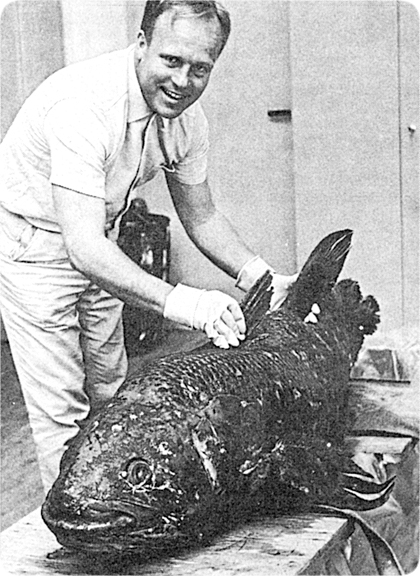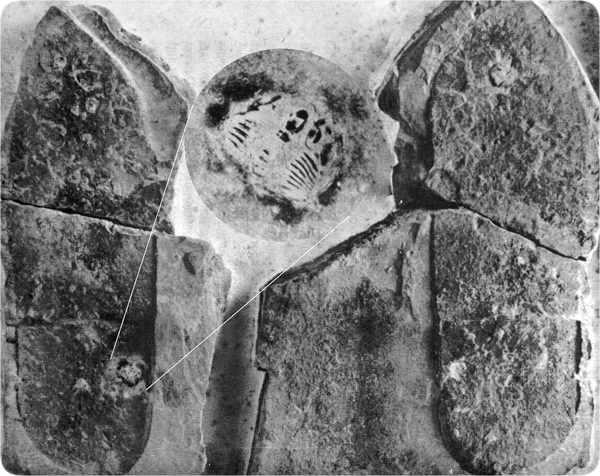Index Fossils 2
Evolution is supposedly shown by the sequence of fossils. Because this reasoning is circular (b), many discoveries, such as living coelacanths, were unexpected. [See"Out-of-Sequence Fossils"onhttp://www.creationscience.com/onlinebook/LifeSciences29.html#wp4031436]
b. “It cannot be denied that from a strictly philosophical standpoint geologists are here arguing in a circle. The succession of organisms has been determined by a study of their remains embedded in the rocks, and the relative ages of the rocks are determined by the remains of organisms that they contain.”R. H. Rastall, “Geology,” Encyclopaedia Britannica,Vol. 10, 1954, p. 168.
“Are the authorities maintaining, on the one hand, that evolution is documented by geology and, on the other hand, that geology is documented by evolution? Isn’t this a circular argument?”Larry Azar, “Biologists, Help!” BioScience, Vol. 28, November 1978, p. 714.
“A circular argument arises: interpret the fossil record in the terms of a particular theory of evolution, inspect the interpretation, and note that it confirms the theory. Well, it would, wouldn’t it? “... the fossils do not form the kind of pattern that would be predicted using a simple NeoDarwinian model.”Thomas S. Kemp, “A Fresh Look at the Fossil Record,” New Scientist, Vol. 108, 5 December 1985, p. 66.
“The intelligent layman has long suspected circular reasoning in the use of rocks to date fossils and fossils to date rocks. The geologist has never bothered to think of a good reply, feeling that explanations are not worth the trouble as long as the work brings results. This is supposed to be hard-headed pragmatism.”J. E. O’Rourke, “Pragmatism Versus Materialism in Stratigraphy,” American Journal of Science, Vol. 276, January 1976, p. 47.
“The rocks do date the fossils, but the fossils date the rocks more accurately. Stratigraphy cannot avoid this kind of reasoning, if it insists on using only temporal concepts, because circularity is inherent in the derivation of time scales.” Ibid., p. 53.
Although O’Rourke attempts to justify the practices of stratigraphers, he recognizes the inherent problems associated with such circular reasoning.
“But the danger of circularity is still present. For most biologists the strongest reason for accepting the evolutionary hypothesis is their acceptance of some theory that entails it. There is another difficulty. The temporal ordering of biological events beyond the local section may critically involve paleontological correlation, which necessarily presupposes the non-repeatability of organic events in geologic history. There are various justifications for this assumption but for almost all contemporary paleontologists it rests upon the acceptance of the evolutionary hypothesis.” Kitts, p. 466.
“It is a problem not easily solved by the classic methods of stratigraphical paleontology, as obviously we will land ourselves immediately in an impossible circular argument if we say, firstly that a particular lithology is synchronous on the evidence of its fossils, and secondly that the fossils are synchronous on the evidence of the lithology.”Derek V. Ager, The Nature of the Stratigraphical Record,3rd edition (New York: John Wiley & Sons, 1993), p. 98.
“The charge that the construction of the geologic scale involves circularity has a certain amount of validity.”David M. Raup, “Geology and Creationism,” Field Museum of Natural History Bulletin, Vol. 54, March 1983, p. 21.
In a taped, transcribed, and approved 1979 interview with Dr. Donald Fisher, the state paleontologist for New York, Luther Sunderland asked Fisher how he dated certain fossils. Answer: “By the Cambrian rocks in which they were found.”When Sunderland asked if this was not circular reasoning, Fisher replied, “Of course; how else are you going to do it?” “The Geologic Column: Its Basis and Who Constructed It,” Bible-Science News Letter, December 1986, p. 6.
“The prime difficulty with the use of presumed ancestral-descendant sequences to express phylogeny is that biostratigraphic data are often used in conjunction with morphology in the initial evaluation of relationships, which leads to obvious circularity.”Bobb Schaeffer, Max K. Hecht, and Niles Eldredge, “Phylogeny and Paleontology,” Evolutionary Biology,Vol. 6 (New York: Appleton-Century-Crofts, Inc., 1972), p. 39.
[http://www.creationscience.com/onlinebook/AstroPhysicalSciences27.html#wp1655298From “In the Beginning” by Walt Brown]
Last edited:


